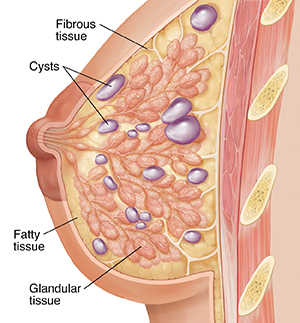What Are Fibrocystic Breasts?
Do your breasts ever feel lumpy, sore, or tender? If so, you may have fibrocystic breasts. This is a very common condition. It is not a disease, and it is not cancer. Your healthcare provider can rule out problems and help you ease your symptoms.
Normal breasts
Your breasts are made up of three kinds of tissue:
-
Glandular tissue is made up of the milk ducts and glands.
-
Fibrous tissue supports the breast.
-
Fatty tissue fills the spaces between the other tissues. It gives the breast its size.
Fibrocystic breasts
Hormones are chemicals that control your menstrual cycle. Hormones can also make glandular tissue swell. This stretches fibrous tissue, making your breasts feel sore. Hormones may also cause one or more fluid-filled lumps to form. These lumps are called cysts. They may be large or small. These cysts are not cancer. This means they are benign. Just before your period, cysts may become larger. Your breasts may feel more sore.

What you may feel
Changes in hormone levels during your menstrual cycle affect your breasts. If you have fibrocystic breasts, your breasts may become sore or even painful. This can often happen before your period. Your breasts may also swell or feel lumpier at this time.
Caring for your breasts
Breast self-awareness is the key to caring for your breasts. Self-awareness means knowing how your breasts normally look and feel. This helps you notice any changes right away. Call your provider if you notice new lumps or changes that feel different than normal. See your provider for regular exams. And have a mammogram as often as your provider suggests.
Online Medical Reviewer:
Donna Freeborn PhD CNM FNP
Online Medical Reviewer:
Heather M Trevino BSN RNC
Online Medical Reviewer:
Todd Gersten MD
Date Last Reviewed:
12/1/2022
© 2000-2024 The StayWell Company, LLC. All rights reserved. This information is not intended as a substitute for professional medical care. Always follow your healthcare professional's instructions.